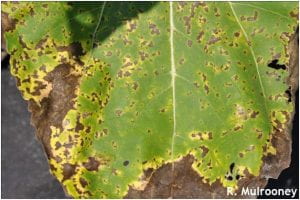Bob Mulrooney, Extension Plant Pathologist; bobmul@udel.edu
Sunflowers are grown both as a crop for oil seed production as well as bird seed. There are many horticultural cultivars as well for flower production. Septoria leafspot as well as Alternaria leafspot are two foliar diseases that are fairly common here in DE. The fungus, Septoria helianthi, occurs on plants of any age but symptoms usually begin on the lower leaves after flowering. The spots are water-soaked at first and can be brown to gray, circular or angular. The recent infection I observed produced a narrow yellow border between the infected and healthy tissue. The spots coalesce and produce irregular dead areas on the leaves. Tiny, indistinct, dark brown pycnidia (flask-shaped spore producing structures) form in the spots. The fungus is believed to overwinter in the infected plant residue and spores splash and driven by rain to host tissue. Humid weather and rainfall are ideal for infection and spread. When conditions are humid and moist, leaves will drop from the bottom of the plant to the top until only a few leaves may remain. Fortunately the disease does not do serious damage to the plants. Disease thresholds for commercial production here are unknown. Headline and other fungicides are labeled for disease control on sunflower.
Septoria leafspot on sunflower.

